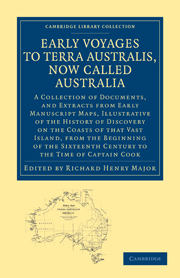 Early Voyages to Terra Australis, Now Called Australia
Early Voyages to Terra Australis, Now Called Australia Book contents
- Frontmatter
- Contents
- INSTRUCTIONS TO THE BINDER
- INTRODUCTION
- A MEMORIAL ADDRESSED TO HIS CATHOLIC MAJESTY PHILIP THE THIRD, KING OF SPAIN
- RELATION OF LUIS VAEZ DE TORRES
- EXTRACT FROM THE BOOK OF DISPATCHES FROM BATAVIA
- THE VOYAGE AND SHIPWRECK OF CAPTAIN FRANCIS PELSART
- VOYAGE OF GERRIT THOMASZ POOL TO THE SOUTH LAND
- ACCOUNT OF THE WRECK OF THE SHIP “DE VERGULDE DRAECK”
- DESCRIPTION OF THE WEST COAST OF THE SOUTH LAND
- EXTRACT TRANSLATED FROM BURGOMASTER WITSEN'S
- ACCOUNT OF THE OBSERVATIONS OF CAPTAIN WILLIAM DAMPIER
- EXTRACT FROM SLOAN MS., 3236
- SOME PARTICULARS RELATING TO THE VOYAGE OF WILLEM DE VLAMINGH
- EXTRACT FROM THE JOURNAL OF A VOYAGE MADE TO THE UNEXPLORED SOUTH LAND
- ACCOUNT OF THE OBSERVATIONS OF CAPTAIN WILLIAM DAMPIER
- A WRITTEN DETAIL OF THE DISCOVERIES AND NOTICEABLE OCCURRENCES
- THE HOUTMAN'S ABROLHOS
- INDEX
- Outline Chart of TERRA AUSTRALIS OF AUSTRALIA
- Plate section
EXTRACT TRANSLATED FROM BURGOMASTER WITSEN'S
Published online by Cambridge University Press: 05 February 2013
- Frontmatter
- Contents
- INSTRUCTIONS TO THE BINDER
- INTRODUCTION
- A MEMORIAL ADDRESSED TO HIS CATHOLIC MAJESTY PHILIP THE THIRD, KING OF SPAIN
- RELATION OF LUIS VAEZ DE TORRES
- EXTRACT FROM THE BOOK OF DISPATCHES FROM BATAVIA
- THE VOYAGE AND SHIPWRECK OF CAPTAIN FRANCIS PELSART
- VOYAGE OF GERRIT THOMASZ POOL TO THE SOUTH LAND
- ACCOUNT OF THE WRECK OF THE SHIP “DE VERGULDE DRAECK”
- DESCRIPTION OF THE WEST COAST OF THE SOUTH LAND
- EXTRACT TRANSLATED FROM BURGOMASTER WITSEN'S
- ACCOUNT OF THE OBSERVATIONS OF CAPTAIN WILLIAM DAMPIER
- EXTRACT FROM SLOAN MS., 3236
- SOME PARTICULARS RELATING TO THE VOYAGE OF WILLEM DE VLAMINGH
- EXTRACT FROM THE JOURNAL OF A VOYAGE MADE TO THE UNEXPLORED SOUTH LAND
- ACCOUNT OF THE OBSERVATIONS OF CAPTAIN WILLIAM DAMPIER
- A WRITTEN DETAIL OF THE DISCOVERIES AND NOTICEABLE OCCURRENCES
- THE HOUTMAN'S ABROLHOS
- INDEX
- Outline Chart of TERRA AUSTRALIS OF AUSTRALIA
- Plate section
Summary
“The north-west part of New Guinea, in 1½° south latitude, and beyond it to the south-east, was for the first time rightly explored in the year 1678, by order of the Dutch East India Company, and found almost everywhere to be enriched with very fine rivers, lakes, bays, etc., but, judging from its outward aspect, the country itself seems to be barren and uncultivated, being in few spots either planted or fenced in. In many parts of the interior there are extremely high mountains, which are seen by sailors at a great distance at sea as if towering above the clouds. The air is not very mild, but very often damp and foggy, so much so that most frequently in the afternoons the land is entirely hidden, which has caused the Dutch East India Company the loss of many ships.
“About the north-western parts, the natives are in general lean and of the middle size, jet black, not unlike the Malabars, but the hair of the head shorter and somewhat less curly than the Caffres. In the black pupil of their eyes gleams a certain tint of red, by which may in some measure be observed that bloodthirsty nature of theirs which has at different times caused us so much grief, from the loss of several of our young men, whom they have surprised, murdered, carried into the woods, and then devoured.
- Type
- Chapter
- Information
- Early Voyages to Terra Australis, Now Called AustraliaA Collection of Documents, and Extracts from Early Manuscript Maps, Illustrative of the History of Discovery on the Coasts of that Vast Island, from the Beginning of the Sixteenth Century, pp. 91 - 98Publisher: Cambridge University PressPrint publication year: 2010First published in: 1859
